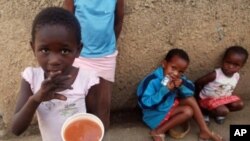A fifth of South Africa’s children are malnourished and many live in socially disrupted households, according to a major report published this week. State statisticians say that 17 years after the country's first democratic elections, black children are still far more disadvantaged than white children or those from other ethnic groups as the roots of the old apartheid system run deep.
Neil Roux, chief statistician for Statistics South Africa, was the team leader of a massive survey of the country's most vulnerable populations. The report covered eight years of progress - or lack of it - on service delivery and to provide data for future planning.
Roux said there is still significant malnourishment among children, although the number of hungry children has dropped by half in the last eight years.
“Yes it still means about a fifth of all children in South Africa live in households that experience hunger but it is a huge improvement since 2002," said Roux.
The report also covered the syndrome of broken and dislocated households in South Africa. The pattern was established when black people were not allowed to work in areas set aside for whites.
“During the apartheid years we had a system of labor migration and group areas and separation and so forth," said Roux. "We had independent homeland areas which were set aside for particular ethnic groups and in those particular areas people had to leave their families and they basically had a pass to work in a white areas for a year and then they had to return to their homeland area and get permission to go back every year depending on demand for their labor.”
He said this migration meant that eight percent of children live with grandparents and only a third of children live with both parents.
Statistics South Africa found that education has made enormous strides in the last eight years, but worryingly, most children are dropping out of school before completing their education, particularly girls.
“One of the positive things is that there has been a consistent growth even since 2002 and almost universal attendance at school," added Neil Roux. "What is worrying after age of 16 roughly there is a huge decrease in the number of children that attend school.”
The report also showed the patterns of unequal access to health care, with 86.5 percent of black children seeking medical care at public hospitals, while 87.3 percent of white children use private facilities.
More than a third of black children lived in households where no single member of that household was employed, which suggests they are likely to go into adulthood unemployed.
Mekonnen Woldegordis from the South African office of the U.N. Children's Fund, UNICEF, said although this report reveals troubling numbers about the state of South Africa’s children, the government has demonstrated, in his words, significant intent to improve their conditions.
Roux said the report by Statistics South Africa involved 36,000 households and was designed to track social development for various government agencies. The report also tracked access to housing, water, electricity and other basic services.















